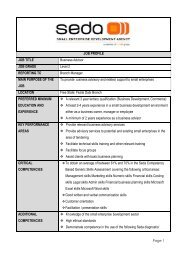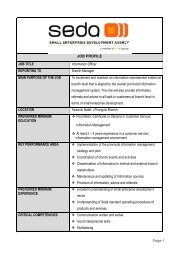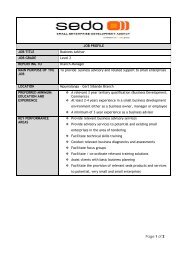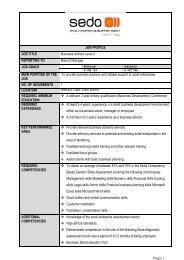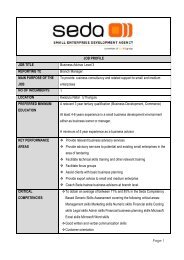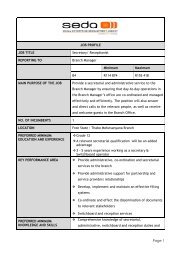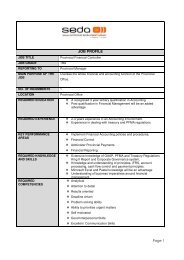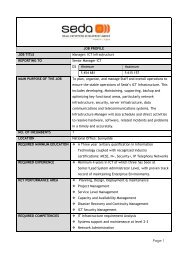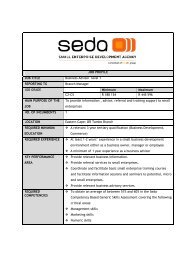Assessment of Cooperatives in the Poultry Industry - 2013.pdf - Seda
Assessment of Cooperatives in the Poultry Industry - 2013.pdf - Seda
Assessment of Cooperatives in the Poultry Industry - 2013.pdf - Seda
You also want an ePaper? Increase the reach of your titles
YUMPU automatically turns print PDFs into web optimized ePapers that Google loves.
2013<br />
Research Report: Address<strong>in</strong>g <strong>the</strong> Needs, Opportunities and Challenges <strong>of</strong> <strong>Cooperatives</strong><br />
and Collectively Owned Enterprises <strong>in</strong> <strong>the</strong> <strong>Poultry</strong> and Related Industries<br />
1.4. Approach<br />
The methodology followed <strong>in</strong> undertak<strong>in</strong>g <strong>the</strong> research study <strong>in</strong>itially takes an academic research<br />
approach, aimed at provid<strong>in</strong>g a general overview and <strong>the</strong>oretical understand<strong>in</strong>g <strong>of</strong> <strong>the</strong> poultry<br />
<strong>in</strong>dustry <strong>in</strong> South Africa. The research approach focuses on <strong>in</strong>tegrat<strong>in</strong>g stakeholder consultations<br />
with a policy overview <strong>in</strong> order to identify <strong>the</strong> areas <strong>of</strong> specific demand or opportunity for <strong>the</strong><br />
provision <strong>of</strong> products and services for cooperatives <strong>in</strong> <strong>the</strong> South African market as well as to provide<br />
guidel<strong>in</strong>es for SEDA to support cooperatives <strong>in</strong> <strong>the</strong> <strong>in</strong>dustry.<br />
After <strong>the</strong> project <strong>in</strong>ception was completed and <strong>the</strong> goals, objectives and outcomes <strong>of</strong> <strong>the</strong> study were<br />
determ<strong>in</strong>ed, a literature review was conducted. The literature review <strong>in</strong>cluded legislation relat<strong>in</strong>g to<br />
<strong>the</strong> poultry and cooperative <strong>in</strong>dustry. Apart from <strong>the</strong> legislation <strong>the</strong> literature review also focuses on<br />
<strong>the</strong> national and prov<strong>in</strong>cial policies as well as support structure <strong>in</strong> <strong>the</strong> <strong>in</strong>dustry. The support<br />
structures were identified to formulate guidel<strong>in</strong>es for SEDA to assist <strong>in</strong> <strong>the</strong> development <strong>of</strong> poultry<br />
cooperatives.<br />
As part <strong>of</strong> <strong>the</strong> desktop research <strong>the</strong> project team also developed a poultry value cha<strong>in</strong>. The purpose<br />
<strong>of</strong> <strong>the</strong> value cha<strong>in</strong> was to identify <strong>the</strong> core function as well as forward and backward l<strong>in</strong>kages <strong>in</strong> <strong>the</strong><br />
sector. By analys<strong>in</strong>g <strong>the</strong> value cha<strong>in</strong> it becomes possible to identify support functions where<br />
cooperatives could be <strong>in</strong>cluded as part <strong>of</strong> <strong>the</strong> value cha<strong>in</strong> through <strong>in</strong>clusive bus<strong>in</strong>ess.<br />
After <strong>the</strong> desktop research, stakeholders who need to be consulted were identified. These<br />
consultations were undertaken after <strong>the</strong> desktop research, allow<strong>in</strong>g <strong>the</strong> project team to fully<br />
understand <strong>the</strong> poultry <strong>in</strong>dustry <strong>in</strong> South Africa. The consultations were conducted across South<br />
Africa to ensure that a representative sample were <strong>in</strong>terviews. The purpose <strong>of</strong> <strong>the</strong> consultations was<br />
to obta<strong>in</strong> <strong>in</strong>formation from cooperatives that operates <strong>in</strong> <strong>the</strong> <strong>in</strong>dustry. The <strong>in</strong>formation was used as<br />
basis for <strong>the</strong> identification <strong>of</strong> opportunities for cooperatives <strong>in</strong> <strong>the</strong> sector.<br />
The f<strong>in</strong>al section <strong>of</strong> <strong>the</strong> report, after <strong>the</strong> primary <strong>in</strong>formation was analysed, was to provide<br />
guidel<strong>in</strong>es for SEDA to support cooperatives <strong>in</strong> <strong>the</strong> South Africa poultry <strong>in</strong>dustry. The study was used<br />
as a research report to identify a strategy to uplift cooperative <strong>in</strong> South Africa to become<br />
competitive <strong>in</strong> <strong>the</strong> market.<br />
1.5. Report Outl<strong>in</strong>e<br />
The question <strong>of</strong> how SEDA is able to better assist cooperatives <strong>in</strong> <strong>the</strong> poultry <strong>in</strong>dustry is addressed <strong>in</strong><br />
this report.<br />
The report consists <strong>of</strong> six chapters; a description <strong>of</strong> <strong>the</strong> content and purpose <strong>of</strong> each chapter has<br />
been summarised <strong>in</strong> Table 1.1 below.<br />
4 | P a g e U r b a n - E c o n : D e v e l o p m e n t E c o n o m i s t s



